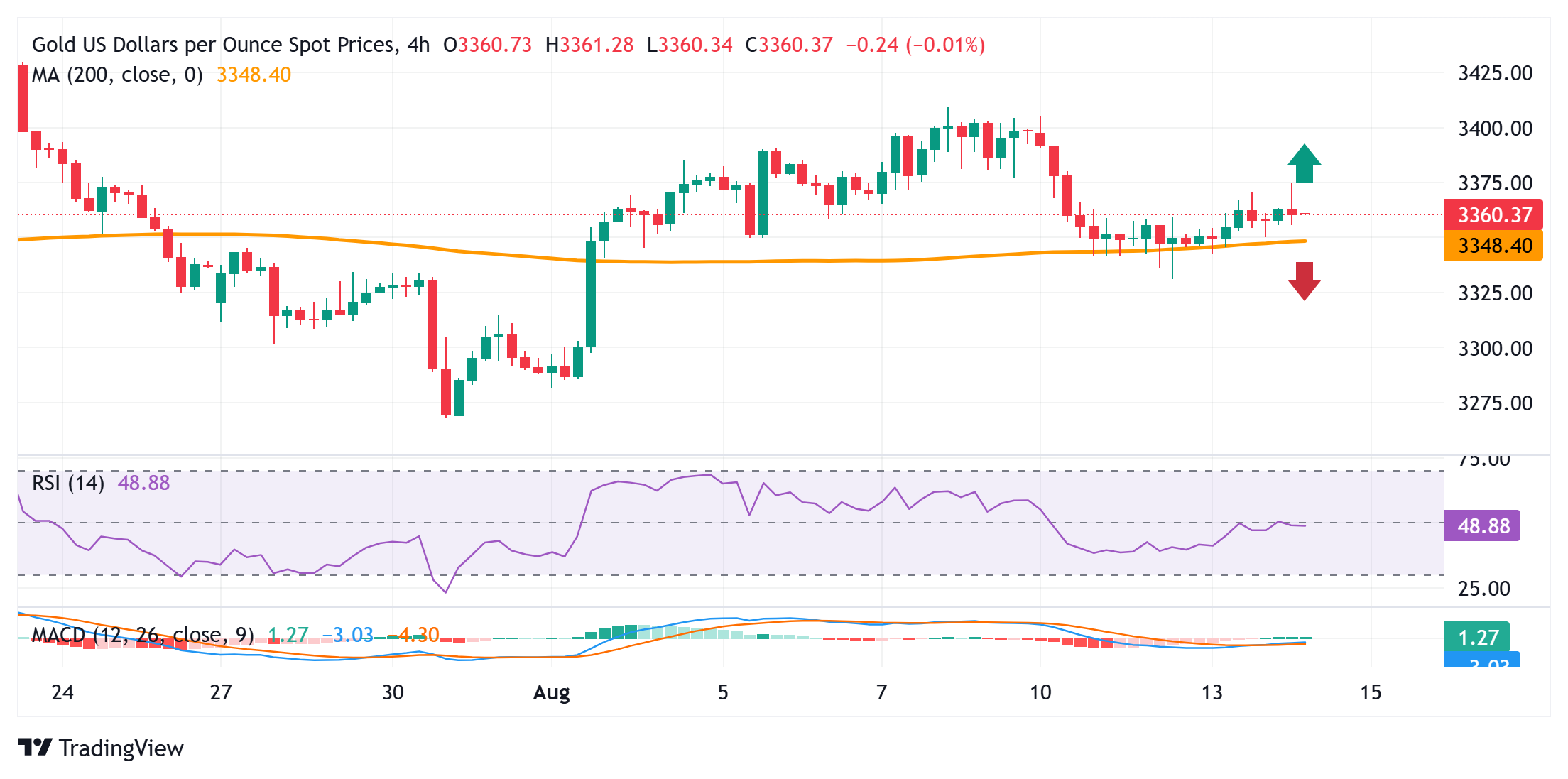Created
: 2025.08.14














![]() 2025.08.14 13:22
2025.08.14 13:22
Gold (XAU/USD) struggles to capitalize on its modest Asian session gains to a three-day peak and attracts some intraday sellers near the $3,375 region. The global risk sentiment remains well supported by the optimism over an extension of the US-China trade truce for another three months and the US-Russia summit on Friday aimed at ending the war in Ukraine. This, in turn, acts as a headwind for the safe-haven precious metal. However, a combination of supporting factors favors bullish traders and backs the case for the emergence of some dip-buying.
The US Dollar (USD) selling bias remains unabated in the wake of the growing acceptance that the US Federal Reserve (Fed) will lower borrowing costs in September. Furthermore, traders have been pricing in the possibility that the Fed will cut interest rates twice by the end of this year, which, in turn, should continue to act as a tailwind for the non-yielding Gold. This makes it prudent to wait for some follow-through selling before confirming that the recent bounce from the $3,331 area, or over a one-week low touched on Tuesday, has run out of steam.

The overnight breakout through the $3,358-3,360 barrier comes on top of the resilience below the 200-period Simple Moving Average (SMA) on the 4-hour chart earlier this week and favors the XAU/USD bulls. That said, oscillators on hourly/daily charts have been struggling to gain positive traction, making it prudent to wait for some follow-through buying before positioning for further gains.
In the meantime, the Asian session peak, around the $3,375 area, could act as an immediate resistance, above which the Gold price could aim towards reclaiming the $3,400 round figure. This is closely followed by last week's swing high, around the $3,409-3,410 area, which, if cleared, should pave the way for a move towards the $3,422-3,423 intermediate resistance. The momentum could eventually lift the commodity beyond the $3,434-3,435 region, towards challenging the all-time peak, around the $3,500 psychological mark touched in April.
On the flip side, the weekly low, weakness below the $3,243-3,242 region (200-period SMA on H4) could find some support near the $3,331 area, or the weekly low. Some follow-through selling could make the Gold price vulnerable to accelerate the slide to the $3,300 round figure. A convincing break below the latter would shift the near-term bias in favor of bearish traders and set the stage for a further depreciating move.
In the world of financial jargon the two widely used terms "risk-on" and "risk off'' refer to the level of risk that investors are willing to stomach during the period referenced. In a "risk-on" market, investors are optimistic about the future and more willing to buy risky assets. In a "risk-off" market investors start to 'play it safe' because they are worried about the future, and therefore buy less risky assets that are more certain of bringing a return, even if it is relatively modest.
Typically, during periods of "risk-on", stock markets will rise, most commodities - except Gold - will also gain in value, since they benefit from a positive growth outlook. The currencies of nations that are heavy commodity exporters strengthen because of increased demand, and Cryptocurrencies rise. In a "risk-off" market, Bonds go up - especially major government Bonds - Gold shines, and safe-haven currencies such as the Japanese Yen, Swiss Franc and US Dollar all benefit.
The Australian Dollar (AUD), the Canadian Dollar (CAD), the New Zealand Dollar (NZD) and minor FX like the Ruble (RUB) and the South African Rand (ZAR), all tend to rise in markets that are "risk-on". This is because the economies of these currencies are heavily reliant on commodity exports for growth, and commodities tend to rise in price during risk-on periods. This is because investors foresee greater demand for raw materials in the future due to heightened economic activity.
The major currencies that tend to rise during periods of "risk-off" are the US Dollar (USD), the Japanese Yen (JPY) and the Swiss Franc (CHF). The US Dollar, because it is the world's reserve currency, and because in times of crisis investors buy US government debt, which is seen as safe because the largest economy in the world is unlikely to default. The Yen, from increased demand for Japanese government bonds, because a high proportion are held by domestic investors who are unlikely to dump them - even in a crisis. The Swiss Franc, because strict Swiss banking laws offer investors enhanced capital protection.
![]()
Created
: 2025.08.14
![]()
Last updated
: 2025.08.14

FXStreet is a forex information website, delivering market analysis and news articles 24/7.
It features a number of articles contributed by well-known analysts, in addition to the ones by its editorial team.
Founded in 2000 by Francesc Riverola, a Spanish economist, it has grown to become a world-renowned information website.
We hope you find this article useful. Any comments or suggestions will be greatly appreciated.
We are also looking for writers with extensive experience in forex and crypto to join us.
please contact us at [email protected].
Disclaimer:
All information and content provided on this website is provided for informational purposes only and is not intended to solicit any investment. Although all efforts are made in order to ensure that the information is correct, no guarantee is provided for the accuracy of any content on this website. Any decision made shall be the responsibility of the investor and Myforex does not take any responsibility whatsoever regarding the use of any information provided herein.
The content provided on this website belongs to Myforex and, where stated, the relevant licensors. All rights are reserved by Myforex and the relevant licensors, and no content of this website, whether in full or in part, shall be copied or displayed elsewhere without the explicit written permission of the relevant copyright holder. If you wish to use any part of the content provided on this website, please ensure that you contact Myforex.
Myforex uses cookies to improve the convenience and functionality of this website. This website may include cookies not only by us but also by third parties (advertisers, log analysts, etc.) for the purpose of tracking the activities of users. Cookie policy